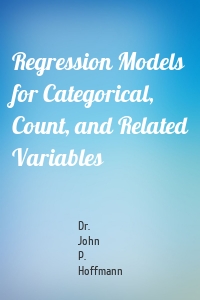Dr. John P. Hoffmann
2 кн.
Regression Models for Categorical,...
Social science and behavioral science students and researchers are often confronted with data that are categorical, count a phenomenon, or have been collected over time. Sociologists examining the likelihood of interracial marriage, political scientists studying voting behavior, criminologists counting the number of offenses people commit, health scientists studying the number of suicides across neighborhoods, and psychologists modeling mental health treatment success are all interested in...
| Автор | Dr. John P. Hoffmann |
Principles of Data Management and P...
The world is saturated with data. We are regularly presented with data in words, tables, and graphics. Students from many academic fields are now expected to be educated about data in one form or another. Yet the typical sequence of courses—introductory statistics and research methods—does not provide sufficient information about how to focus in on a research question, how to access data and work with datasets, or how to present data to various audiences.<BR />...
| Автор | Dr. John P. Hoffmann |



